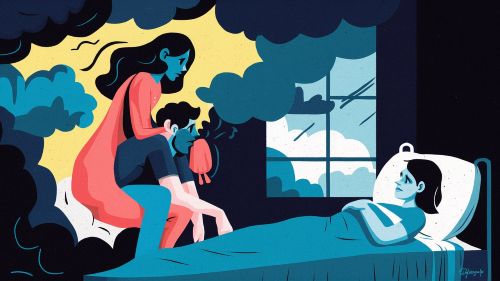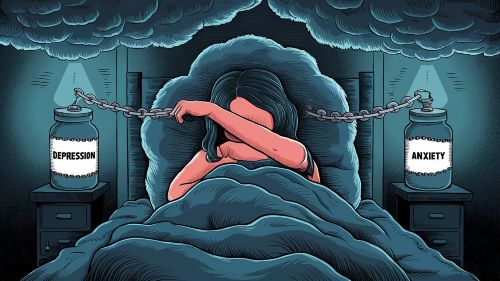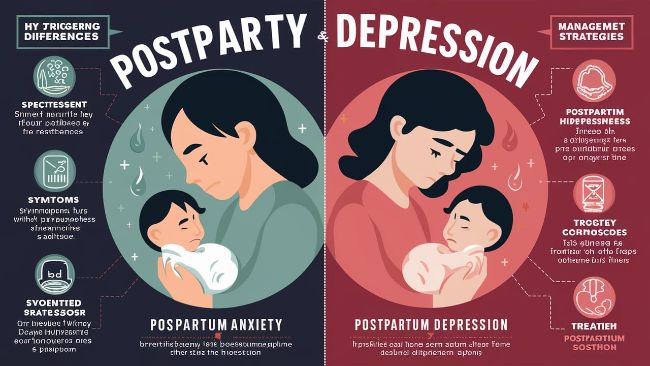In the whirlwind of new motherhood, your internal world can feel as chaotic as the pile of laundry in the corner. You’re exhausted, overwhelmed, and your emotions are running high. You know something isn’t right, but you can’t quite put your finger on it. You’ve heard of postpartum depression (PPD), the deep sadness that can descend after birth, but what you’re feeling doesn’t exactly fit that description.
Instead of sadness, maybe you feel a relentless, humming sense of dread. Your mind races with terrifying “what if” scenarios. You can’t sleep, not because the baby is crying, but because you’re consumed by worry.
If this sounds familiar, you might not be dealing with PPD alone. You could be experiencing its often-overlooked sibling: Postpartum Anxiety (PPA).
While PPD gets more media attention, PPA is just as common—if not more so. Understanding the key differences between these two conditions is not just an academic exercise. It is a critical step toward validating your experience, finding the right language to ask for help, and getting on the most effective path to recovery.
In this guide, we will untangle the threads of postpartum anxiety and depression, providing a clear, side-by-side comparison to help you understand what you’re feeling and, most importantly, know that you are not alone and help is available.
[Insert a calming, empathetic image here: a mother holding a cup of tea, looking out a window, or a close-up of a hand being held.]
What is Postpartum Anxiety (PPA)? The Constant “What If”
Everyone worries about their new baby. Am I doing this right? Is the baby breathing? Are they getting enough to eat? This is a normal, evolutionary response designed to keep a vulnerable infant safe.
Postpartum Anxiety, however, is when this normal worry escalates into a state of constant, excessive fear that disrupts your daily life. It’s not just a passing thought; it’s a mental state of high alert that you can’t turn off.
Imagine your brain’s “alarm system” is stuck in the ON position. Instead of activating only in response to a real threat, it rings constantly, flooding your body with adrenaline and your mind with worst-case scenarios.
Common symptoms of Postpartum Anxiety include:
- Mental Symptoms:
- Racing, intrusive thoughts you can’t control.
- Constant worry or a feeling of dread that something terrible is about to happen.
- An inability to relax or “turn your mind off.”
- Obsessive thoughts, often centered on the baby’s health and safety.
- Physical Symptoms:
- A feeling of being “on edge” or jumpy.
- Heart palpitations, a racing heart, or chest tightness.
- Dizziness, hot flashes, and nausea.
- Shortness of breath.
- Trouble sleeping (difficulty falling asleep because your mind is racing).
- Loss of appetite.
- Behavioral Symptoms:
- Constantly checking on the baby (e.g., watching them breathe all night).
- An obsessive need for control and order.
- Avoiding certain situations or places out of fear (e.g., not driving with the baby).
- Needing constant reassurance from your partner, family, or doctor.
Key Point: The defining feature of PPA is fear. It’s a future-oriented condition, fixated on all the terrible things that could happen.
A Recap of Postpartum Depression (PPD): The Heavy Cloud
Since you’re on the PP Depression blog, you may be more familiar with the signs of Postpartum Depression. PPD is a clinical mood disorder characterized by a persistent feeling of sadness and a loss of interest in activities you once enjoyed.
Where anxiety is a state of hyper-arousal, depression is often a state of “hypo-arousal”—a feeling of being shut down, heavy, and numb. The world, which should feel vibrant with a new baby, instead seems gray and joyless.
Core symptoms of Postpartum Depression include:
- Persistent sadness, emptiness, or hopelessness.
- Crying spells with no apparent reason.
- Anhedonia: A significant loss of pleasure or interest in almost all activities.
- Feelings of worthlessness, shame, or excessive guilt (e.g., “I’m a bad mother”).
- Severe fatigue and loss of energy that sleep doesn’t fix.
- Changes in sleep patterns (insomnia or sleeping too much).
- Difficulty concentrating, remembering details, or making decisions.
- Withdrawal from friends, family, and social situations.
- Thoughts of death, self-harm, or harming the baby. [Link to your article on PPD Symptoms]
Key Point: The defining feature of PPD is sadness and loss. It’s a past- or present-oriented condition, fixated on feelings of failure, hopelessness, and despair about the way things are.

The Core Differences: Postpartum Anxiety vs. Depression Side-by-Side
Seeing the symptoms listed out is helpful, but the best way to understand the difference is to compare them directly. While there is significant overlap, the core emotional experience is distinct.
Use this table to see which column resonates more with your experience.
| Feature | Postpartum Anxiety (PPA) | Postpartum Depression (PPD) |
|---|---|---|
| Dominant Emotion | Fear, dread, panic. | Sadness, hopelessness, emptiness. |
| Main Thought Pattern | Future-focused “What Ifs”: “What if the baby stops breathing?” “What if I drop him?” “What if I crash the car?” | Past/Present-focused Negativity: “I’m a failure as a mother.” “I’m not bonding with my baby.” “This will never get better.” |
| Energy Level | “Wired but tired.” You feel physically exhausted but your mind is racing, preventing rest. A constant sense of being on edge. | Deep fatigue and lethargy. A heavy feeling in your body and mind. Even small tasks feel monumental. |
| Physical Sensations | Adrenaline-fueled: Racing heart, shortness of breath, dizziness, stomach churning, muscle tension. | Heavy and achy: Unexplained aches and pains, a feeling of being weighed down, slowness of movement. |
| Motivation | Can be high, but driven by fear. You might obsessively clean or research baby products as a way to control your environment and anxiety. | Extremely low. A profound lack of motivation to do anything, including self-care or activities you once enjoyed. |
| Sleep | Difficulty falling asleep. You lie down, but your brain won’t shut off. You replay worries and fears. | Difficulty staying asleep or oversleeping. You might wake up in the middle of the night filled with dread, or feel a desire to sleep all the time to escape. |
| Self-Perception | “I’m going crazy.” “I’m losing control.” | “I’m a bad person.” “I’m worthless.” |
[Use the WordPress “Table” block to build this table for maximum visual impact and readability.]
The Big Question: Can You Have Both PPA and PPD?
After reading the table, you might be thinking, “I feel like I have symptoms from both columns.”
If so, you are not confused—you are normal.
The answer is a resounding YES. In the world of perinatal mental health, PPA and PPD are not mutually exclusive. In fact, they are highly comorbid, meaning they often occur together. Research from the American College of Obstetricians and Gynecologists (ACOG) suggests that at least 50% of women with PPD also have a co-occurring anxiety disorder.
Think of them as unwelcome houseguests who often bring a friend. The crushing weight of depression can fuel anxiety about your ability to cope, while the relentless churn of anxiety can be so exhausting and demoralizing that it leads to depression.
Related Conditions: Postpartum OCD and Rage
It’s also important to know about other conditions that can fall under the perinatal mood and anxiety disorder (PMAD) umbrella:
- Postpartum OCD (Obsessive-Compulsive Disorder): Characterized by obsessions (persistent, intrusive, and unwanted thoughts or mental images, often related to the baby’s safety) and compulsions (repetitive actions performed to reduce the anxiety caused by the obsessions). For example, a mother might have a horrific, unwanted image of harming her baby (obsession) and then hide all the knives in the house (compulsion). These thoughts are NOT a reflection of her desires and are deeply distressing to her.
- Postpartum Rage: This is not a formal diagnosis but a very real symptom. It manifests as sudden, intense, and often uncontrollable anger or irritability. It can be a symptom of both PPA (feeling overwhelmed and out of control) and PPD (low tolerance for frustration). [Link to an article on Postpartum Rage if you have one].
Stories from the Trenches: What PPA and PPD Feel Like
To make this real, here are two stories that illustrate the different “flavors” of these conditions.
Maria’s Story (Primarily PPA):
“From the moment we brought Leo home, I was terrified. I couldn’t sleep. I’d just lie there, listening to him breathe. I set alarms to make sure he was still alive. My husband would find me at 3 a.m. frantically Googling SIDS statistics. I loved Leo so much it hurt, but the love was tangled up in this horrifying fear that I was going to lose him or that I’d mess up in some catastrophic way. I felt like I was vibrating with a nervous energy I couldn’t burn off.”
Jessica’s Story (Primarily PPD):
“Everyone told me I’d feel this rush of love, but I just felt… nothing. It was like I was watching my life from behind a thick pane of glass. Changing diapers, feeding, rocking—it was all mechanical. I felt so guilty. I’d look at my beautiful daughter and think, ‘She deserves a better mom.’ I cried all the time but I couldn’t explain why. I just felt this profound sadness and emptiness, and I truly believed it would never end.”
[Use the WordPress “Quote” block for each story to make them stand out visually. Give the block a light background color.]
Why It Matters: Getting the Right Treatment
Differentiating between PPA and PPD is vital because while treatments overlap, the focus of that treatment can be tailored for better results. When you talk to your doctor or a therapist, being able to say, “I think it’s more anxiety than sadness,” can guide them toward the most effective strategies for you.
Both PPA and PPD are highly treatable. The main treatment avenues are the same:
- Therapy (Psychotherapy): Cognitive Behavioral Therapy (CBT) is effective for both, but the application differs.
- For Anxiety: Therapy will focus on challenging catastrophic “what if” thinking, learning grounding techniques to manage panic, and gradual exposure to feared situations.
- For Depression: Therapy will focus on “behavioral activation” (taking small steps to re-engage in life), challenging negative self-talk and feelings of worthlessness, and processing grief or loss.
- Medication: The most commonly prescribed medications, SSRIs (Selective Serotonin Reuptake Inhibitors), are effective for treating both anxiety and depression. They are the frontline treatment for a reason and many are safe for breastfeeding.
- Support Systems: Connecting with others is crucial for both conditions. Support groups, whether for PMADs in general or just new moms, combat the isolation that fuels both anxiety and depression.
[Insert an image here representing support: two women talking, a therapy session (from behind), or a support group circle.]

Frequently Asked Questions (FAQ)
Q1: Is Postpartum Anxiety as common as Postpartum Depression?
Yes. Current research suggests that PPA may be even more common than PPD. Estimates show that up to 21% of new mothers experience a significant postpartum anxiety disorder, while about 15% experience PPD. Many experience both.
Q2: Can postpartum anxiety include scary thoughts about the baby?
Absolutely. This is a hallmark symptom of both PPA and Postpartum OCD. These are called “intrusive thoughts,” and they are ego-dystonic, meaning they are the opposite of what you want. Having a scary thought about dropping the baby does not mean you will do it; it’s a manifestation of extreme anxiety about the baby’s safety. It’s crucial to talk about these thoughts with a therapist who understands PMADs.
Q3: How do I talk to my doctor if I’m not sure what I have?
You don’t need a self-diagnosis. The most important thing is to be honest about your symptoms. You can say:
- “I’m not feeling like myself.”
- “I’m constantly worried and on edge.”
- “I feel very sad and have no motivation.”
- “I can’t sleep, even when the baby is sleeping.”
Describe your feelings as best you can. A good doctor will ask screening questions to help differentiate between anxiety and depression.
Q4: Will PPA or PPD go away on its own?
Like PPD, postpartum anxiety is a clinical condition that rarely resolves on its own. Trying to “tough it out” often prolongs suffering. Seeking professional help is the bravest and most effective thing you can do for yourself and your family.
The First Step is Naming It. The Next is Getting Help.
The postpartum period is a profound transformation. It’s no wonder that it can bring our deepest fears and vulnerabilities to the surface. For you, that may manifest as the frantic, future-focused fear of anxiety, the heavy, present-focused sadness of depression, or a confusing and exhausting mix of both.
Here is the most important takeaway: You do not need to have the perfect label for your struggle to deserve help.
Whether you identify more with Maria’s story of anxiety or Jessica’s story of depression, the path forward is the same. It begins with raising your hand and saying, “Something is wrong, and I need support.”
Naming your experience—anxiety, depression, both—is a powerful act of validation. It confirms that what you’re feeling is real, it’s a recognized medical condition, and it’s not your fault. And best of all, it’s treatable.
You will feel like yourself again. The joy will return. The peace will settle. It starts with one small, brave step.
